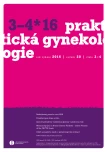Can semi-quantitative analysis of amniotic fluid glucose be useful in gynecology and obstetrics? A pilot study.
Authors:
Beáta Veliká 1; Anna Birková 1; Rastislav Dudič 2; Ivana Špaková 1; Peter Urdzík 2
Authors‘ workplace:
Ústav lekárskej a klinickej biochémie LF UPJŠ v Košiciach
1; Gynekologicko-pôrodnícka klinika LF UPJŠ v Košiciach a UNLP Košice
2
Published in:
Prakt Gyn 2016; 20(3-4): 138-142
Category:
Gynecology and Obstetrics
Overview
Amniotic fluid represent a biological fluid, which reflect metabolic state of the fetus, the study of its components and their changes in different gestational weeks provide useful information about the growth and maturation of the fetus under physiological, as well as pathological conditions. Concentration of glucose in amniotic fluid is considered as predictive marker of fetus weight, of intrauterine infection, it reflects the fetal maturity, maternal metabolic state, but is also connected with some births defects. In our study, we focused on the detection of specific gravity, proteins, nitrites, pH, leukocytes and glucose level in amniotic fluid, in different weeks of pregnancy by diagnostic strips. Very interesting results were obtained in the semi-quantitative evaluation of glucose concentration. Under physiological conditions the glucose concentration in amniotic fluid progressively decreases with weeks of pregnancy, on the basis of which it is foreseeable potential use of rapid-strip tests and in clinical practice, where available amniotic fluid.
Key words:
amniotic fluid – glucose –strip test
Sources
1. Beall MH, van den Wijngraard JP, van Gemert MJ et al. Amniotic fluid water dynamics. Placenta 2007; 28(8–9): 816–823.
2. Underwood MA, Gilbert WM, Sherman M.P. Amniotic fluid: not just fetal urine anymore. J Perinatol 2005; 25(5): 341–348.
3. Kirshon B, Rosenfeld B, Mari G et al. Amniotic fluid glucose and intraamniotic infection. Am J Obstet Gynecol 1991; 164(3): 818–820.
4. Hollý I, Šimko M, Šimko J et al. Markery zápalu v plodovej vode v II.trimestri gravidity. Prakt Gyn 2002; 6(1): 12–13.
5. Tarim E, Bagis T, Kilicdag EB et al. Are amniotic fluid C-reactive protein and glucose levels, and white blood cell counts at the time of genetic amniocentesis related with preterm delivery? J Perinat Med 2005; 33(6): 524–529.
6. Stefos T, Sotiriadis A, Kaponis A et al. Amniotic fluid glucose at the time of genetic amniocentesis: correlation with duration of pregnancy and birthweight. Eur J Obstet Gynecol Reprod Biol 2003; 106(2): 144–147.
7. Oliveira FR, Barros FR, Magalhaes JA. Biochemical profile of amniotic fluid for the assessment of fetal and renal development. Braz J Med Biol Res 2002; 35(2): 215–222.
8. Iyengar L, Rao V, Kumar S. Significance of amniotic fluid glucose in pregnancy. Int J Gynaecol Obstet 1982; 20(1): 57–63.
9. Informace dostupné z WWW: <http://www.questdiagnostics.com/testcenter/BUOrderInfo.action?tc=17423X&labCode=SJC>.
10. Fotiou M, Michaelidou AM, Athanasiadis AP et al. Second trimester amniotic fluid glucose, uric acid, phosphate, potassium, and sodium concentrations in relation to maternal pre-pregnancy BMI and birth weight centiles. J Matern Fetal Neonatal Med 2015; 28(8): 910–915.
11. Dildy GA, Pearlman MD, Smith LG et al. Amniotic Fluid Glucose Concentration: A Marker for Infection in Preterm Labor and Preterm Premature Rupture of Membranes. Infect Dis Obstet Gynecol 1994; 1(4): 166–172.
12. Ozgu-Erdinc AS, Cavkaytar S, Aktulay A et al. Mid-trimester maternal serum and amniotic fluid biomarkers for the prediction of preterm delivery and intrauterine growth retardation. J Obstet Gynaecol Res 2014; 40(6): 1540–1546.
13. Krantz D, Hallanhan T, Janik D et al. Maternal Serum Screening Markers and Adverse Outcome: A New Perspective. J Clin Med 2014; 3(3): 693–712.
14. Chan RL. Biochemical Markers of Spontaneous Preterm Birth in Asymptomatic Women. Bio Med Res Int J 2014; 2014: 164081. Dostupné z DOI: <http://dx.doi.org/10.1155/2014/164081>
15. Rule AH, Sliogeris V, Farber M et al. Relation of glucose to alpha-fetoprotein in amniotic fluid. Obstet Gynecol 1981; 57(3): 310–312.
16. Briese V, Straube W. Relation of AFP and glucose in amniotic fluid. Zentralbl Gynakol 1983; 105(7): 434–439.
17. Levkovitz R, Zaretsky U, Jaffa AJ et al. In vitro simulation of placental transport: part II. Glucose transfer across the placental barrier model. Placenta 2013; 34(8) : 708–715.
18. Elad D, Levkovitz R, Jaffa AJ et al. Have we neglected the role of fetal endothelium in transplacental transport? Traffic 2014; 15(1): 122–126.
Labels
Paediatric gynaecology Gynaecology and obstetrics Reproduction medicineArticle was published in
Practical Gynecology

2016 Issue 3-4
Most read in this issue
- Physiotherapy after gynecologic abdominal surgery
- Conservative therapy of interstitial pregnancy with the use of methotrexate – case study
- Preeclampsia today and tomorrow
- Pain-free childbirth in 2016
